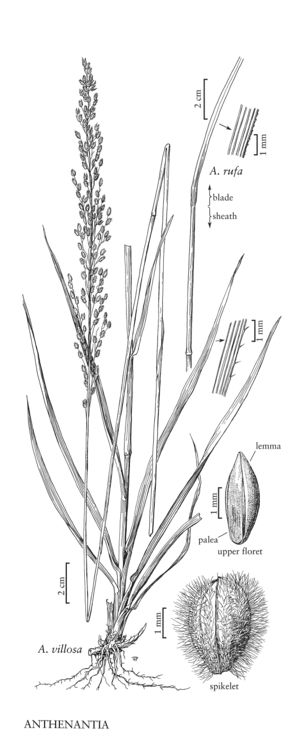| Taxon | Illustrator ⠉ | |
|---|---|---|
 | Anthenantia rufa Anthenantia villosa | Hana Pazdírková Linda A. Vorobik Hana Pazdírková Linda A. Vorobik |
Plants perennial; rhizomatous. Culms 60-120 cm, stiffly erect, clustered. Sheaths open; ligules 0.1-0.3 mm, membranous, ciliate; blades flat, stiff, upper blades much reduced. Inflorescences terminal, simple panicles with elongate rachises; branches ascending to erect, not spikelike, lower branches usually with 8 or more spikelets; disarticulation beneath the glumes. Spikelets 3-4 mm, laterally compressed neither subtended by bristles nor sunken into the rachis, elliptic, obovoid, hirsute, unawned, with 2 florets. Lower glumes absent; upper glumes as long as the spikelets, obovate, densely hirsute, 5-veined; lower florets sterile or staminate; lower lemmas densely hirsute, similar to the upper glumes; lower paleas present or absent; upper lemmas and upper paleas cartilaginous, glabrous, dark-brown, separating slightly at maturity, exposing the caryopses, lemmas 3-veined, margins flat, hyaline, 0.5-1 mm wide, paleas 2-veined. x = 10.
Discussion
Anthenantia is a genus of two species, both of which are endemic to the southeastern United States. It is very similar to Leptocoryphium Nees, a monotypic genus that extends from Mexico to Argentina, but differs in having laterally, rather than dorsally, compressed spikelets.
Selected References
Lower Taxa
Key
| 1 | Junction of the sheath and blade not evident abaxially, the sheath and blades in line with each other; blades 2-5 mm wide, the margins scabrous; leaves 30-60 cm long | Anthenantia rufa |
| 1 | Junction of the sheath and blade evident, the blades not in line with the sheaths; blades 5-10 mm wide, the margins papillose-hispid; leaves mostly less than 30 mm long | Anthenantia villosa |
"decumbent" is not a number.